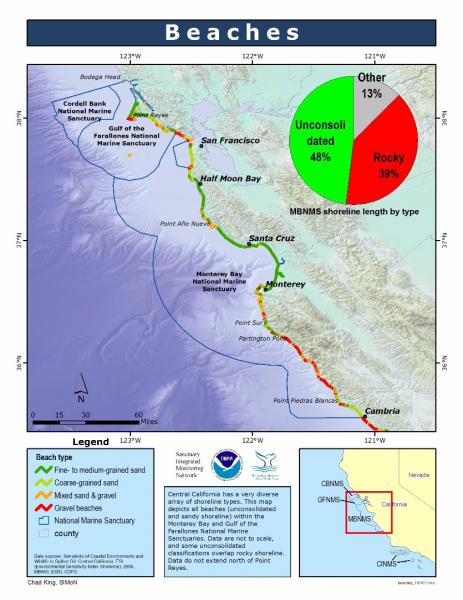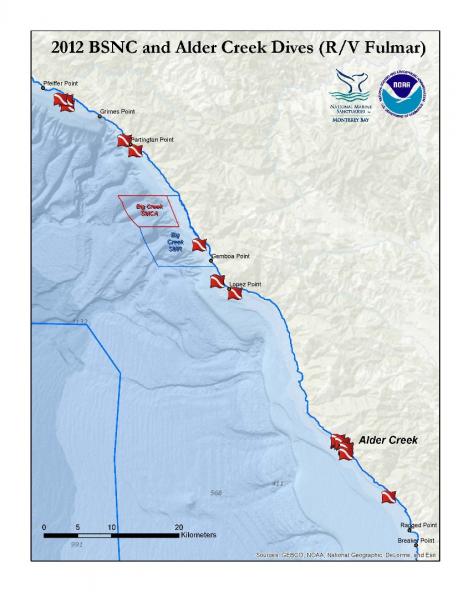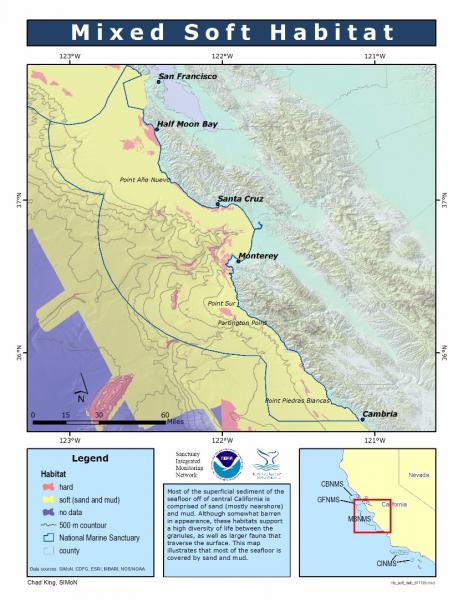Overview
The geologic landscape of the Cordell Bank National Marine Sanctuary is active, varied and beautiful – much like the land above the water. It is the cumulative result of millions of years of the earth’s history, involving the building and subsequent wearing down of mountains, movement during large and small earthquakes, changes in sea level, and the never-ending processes of wind and water erosion and deposition.
The sanctuary’s geologic character can impact the type, location and size of habitats for many marine plant and animal species. Therefore, mapping geologic features and understanding the processes that shape them is essential to recognizing and interpreting change here.
The sanctuary lies completely within the Pacific Plate, but its eastern boundary is located 12 kilometers (7.5 miles) west of the convergence zone of two of the earth’s major tectonic plates: the Pacific and North American.
The Pacific Plate is slowly moving northward relative to the North American Plate, at an average rate of about 2 inches per year. Most of this motion occurs in catastrophic bursts of movement – earthquakes – along the San Andreas fault system.
Cordell Bank is the sanctuary’s most prominent geological feature. Its Salinian bedrock was originally created about 100 million years ago as part of the Sierra Nevada range. When the San Andreas fault formed (20 to 30 million years ago), it sheared off part of the range, including the granitic feature of Cordell Bank, and carried it north to its present location west of Marin County. West of the San Andreas fault, Bodega Head, the Farallon Islands, Point Reyes Peninsula and Cordell Bank are made of granitic bedrock believed to be originally from the southern Sierra Nevada. Cordell Bank and the Farallon Islands are part of the same Farallon Ridge structural high.
Sediments surrounding the base of the bank on the continental shelf are mostly composed of younger silt and sand deposits that originated from rivers and coastal erosion. These sediments continue to be moved around and further broken down by energetic seafloor ocean currents.
The gently seaward-sloping continental shelf, which ranges from 35 to 50 kilometers wide in the sanctuary region, comprises much of the sanctuary. The shelf’s western edge in this region is in about 150 meters (490 feet) of water and coincides with the shoreline of the last ice age, when water was locked up in glaciers and sea level was much lower. The continental shelf is comprised mainly of soft-bottom habitats (sand and silt). Past the shelf break lies the continental slope, where the depth drops off steeply, reaching 2,000 meters within less than 10 kilometers of the break.
Cutting into the continental slope north of Cordell Bank is the second most prominent geological feature of the sanctuary, Bodega Canyon. Over 1,600 m deep, this canyon extends from the continental shelf to the deep sea. Several other small submarine canyons also cut into the continental slope within the sanctuary. Present scientific knowledge about these canyons is limited as they are largely unexplored, but the majority of their habitats is expected to be soft-bottom habitats (sand and silt), while a much smaller portion is predicted to be hard-bottom.
In the sanctuary, most of the soft-bottom areas of the continental shelf are silt. Nevertheless, sand substrates are found in the region east of Cordell Bank, with the occurrence of sand increasing with increasing proximity to the bank.
As recently as about 10,000 years ago, at the end of the last ice age, the great sheets of ice (glaciers) that covered much of the earth’s northern hemisphere began melting – causing worldwide sea level to rise. Sea level rose to its present-day position within about 5,000 years.
The lower sea level during the recent past would have left all of Cordell Bank, as well as the continental shelf, exposed above water level. It is possible that some of the sedimentary and calcareous material found in the region of the bank today is the result of the dramatically different ecosystem that must have existed during this time, when Cordell Bank was an island before being flooded.
Since much of the seafloor in the sanctuary is too deep for human divers, scientists have learned much about it with the help of acoustic instruments (those that use sound sources and listening devices) and underwater cameras and video equipment, using both manned submersibles and remotely operated vehicles. Data have been collected from the sanctuary continental shelf, both soft-bottom and on the rocky bank, that reveal a diversity of habitats that support diverse benthic communities. Little is known about the geology of the sanctuary’s deeper portions on the continental slope.
Monitoring
Cordell Bank Seafloor Mapping
Researchers from California State University Monterey Bay (CSUMB) collected and processed high-resolution backscatter and bathymetry data of Cordell Bank and surrounding soft-bottom areas. Researchers from CSUMB and the U.S. Geological Survey (USGS) used these data (collected in 2005) to develop a benthic habitat map of Cordell Bank and the surrounding region.
Habitat characteristics such as slope, habitat complexity, depth and substrate type were used to describe the physical habitats that make up Cordell Bank and to relate these seafloor features to benthic community patterns. The high-resolution data also provide detailed information on the geomorphology of the bank that can be used in understanding the formation and evolution of this rocky feature.
usSEABED Database
The USGS has spearheaded a major effort to gather diverse geologic data about the continental shelf and organize it through a GIS database. The single integrated data set is a compilation of seabed sample information that has been collected over many years by various ocean expeditions and research programs.
This project, called usSEABED, is an innovative system developed to use both lab-based analyses and numeric data from descriptive data together in a unified database. The database provides unprecedented coverage of the sediment and rock types sampled from the seafloor as well as a searchable catalog of other observations, such as micro and macro flora and fauna and sedimentary structures.
Seafloor Mapping in Monterey Bay, Cordell Bank and Greater Farallones National Marine Sanctuaries
In April 2004, scientists from the National Oceanic and Atmospheric Administration (NOAA) and the U.S. Geological Survey conducted a 21-day research cruise aboard the NOAA Ship McArthur II. This study greatly contributed to our knowledge of the continental shelf in the three central California national marine sanctuaries. During this study, researchers mapped approximately 140 kilometers of the seafloor within Cordell Bank National Marine Sanctuary with side scan sonar. They collected underwater video with a towed camera sled to characterize the habitat types and diversity and the benthic assemblages of sea life on the continental shelf, including a first look at many areas.
Habitat characteristics such as slope, habitat complexity, depth and substrate type are being used to describe the physical habitats that make up the outer continental shelf and to relate these seafloor features to benthic community patterns. Results from this seafloor mapping study provide valuable characterization of sanctuary biology and geology that is useful as a foundation for management of the national marine sanctuaries.
Further mapping is needed to fully characterize the benthic features and habitats of the continental shelf within Cordell Bank National Marine Sanctuary, particularly areas of greater heterogeneity. Such mapping could also be used to understand the extent of marine debris (e.g., derelict fishing gear) in this region as well as to determine if any sunken vessels, which could represent important cultural resources as well as potential polluters, exist within sanctuary boundaries.
Photos
Maps
Shoreline type along the central California coastline

[View Larger]
2012 Big Sur Nearshore Characterization and Alder Creek Dives

[View Larger]
Mixed Soft Habitat

[View Larger]
Projects
Seafloor Mapping in Monterey Bay, Cordell Bank, and Gulf of the Farallones National Marine Sanctuaries
National Oceanic and Atmospheric Administration and U.S. Geological Survey scientists mapped and characterized seafloor areas on the continental shelf in three west coast National Marine Sanctuaries using side-scan sonar and underwater video technology.usSEABED: A USGS Pacific Coast Offshore Surficial Sediment Data and Mapping Project
The USGS will soon publish its first release of Pacific coast data from the usSEABED database, a map-based compilation of offshore surficial sediment data.Links
Big Sur Region Earth Sciences Bibliography
A compilation of citations pertaining to Earth sciences studies performed in the Big Sur region of central coastal California.http://www.ventanawild.org/news/fe02/geobib.html
California Coastal Commission - 1995 ReCAP Pilot Project, Monterey Bay Region: Coastal Hazards
This chapter summarizes ReCAP's investigation of shoreline hazard response -- protection of upland development by armoring, the permitting associated with existing armoring, the impacts from armoring, the policies which address shoreline protection, and the likely changes which will happen to the shoreline in the future assuming existing trends and policies continue.http://www.coastal.ca.gov/recap/chap3.html
California Coastal Mapping Project
The California Coastal Mapping Program is a comprehensive effort to combine seafloor mapping data with shoreline data to create seamless onshore-offshore maps of California's coastline.http://www.opc.ca.gov/2010/01/mapping-californias-coastal-areas/
California Geological Survey - An index to online geologic field trips, including coastal Central California
The California Geotour is an interactive index of Web pages of geologic field trip guides and related Web sites compiled by the California Geological Survey (CGS) for the benefit of all who have wondered about California's geologic features.http://www.conservation.ca.gov/cgs/Pages/Geotours.aspx
Central Coast Watershed Studies (CCoWS)
The Central Coast Watershed Studies (CCoWS) team is part of the Watershed Institute, in the Division of Science and Environmental Policy at California State University Monterey Bay. They conduct research on watersheds that feed into the MBNMS.http://ccows.csumb.edu/home/
CSUMB Seafloor Mapping Lab
At California State University Monterey Bay, students get hands-on research experience with mapping the seafloor. Find out more!http://seafloor.csumb.edu/index.html
Elkhorn Slough Tidal Wetland Plan
The purpose of this collaborative planning process is to conserve, enhance, and restore tidal habitats in the Elkhorn Slough watershed by developing strategies to address hydrological management issues.http://elkhornslough.org/tidalwetlandplan.htm
Investigating Earth Systems
A new, standards-based, Earth Science curriculum for the middle grades developed by the American Geological Institute in association with It's About Time Publishing.http://www.agiweb.org/ies/
MBARI - Current Research Projects
Learn about current research projects conducted by the Monterey Bay Aquarium Research Institute (MBARI).http://www.mbari.org/rd/projects/current_projects.html
MBARI - Mapping the Monterey Canyon
See how the Monterey Bay Aquarium Research Institute (MBARI) is involved in mapping the seafloor of the Monterey Bay National Marine Sanctuary.http://www.mbari.org/canyon/Mapping_Sections.htm
MBNMS Teacher Curriculum - The Land-Sea Connection
Teacher activity "The Land-Sea Connection": Conducting a Transect Along the Seafloor of the Monterey Bay National Marine Sanctuary, takes students in for a close look at the Sanctuary's benthic region. After becoming familiar with a bathymetric/topographic map of the area, students select a transect along the seafloor to study some of the geological, biological, and physical features that are present. Available in both Spanish and English.http://montereybay.nos.noaa.gov/educate/teachercurriculum/investigation2.html
Monterey Bay Aquarium - Student and Teacher Resources and Activities
The Monterey Bay Aquarium offers teacher and student resources including: species and habitat-specific information, live cams, classroom activities, and interactive online games.http://www.mbayaq.org/lc/
Monterey Bay National Marine Sanctuary Site Characterization - Geology
This site characterization of the Monterey Bay National Marine Sanctuary (MBNMS) summarizes available information about MBNMS geology.http://montereybay.noaa.gov/sitechar/geol.html
NOAA - Ocean Exploration Lesson Plans
Students of all ages can learn about the oceans with near real-time access to a series of multidisciplinary deep ocean explorations. The site offers a set of over 100 hands-on and standards-based lesson plans for student exploration and discovery. Using new technological "eyes" to see, sense, measure, image, and describe a little known ocean world, these lessons bring the excitement of late-breaking ocean discoveries into classrooms.http://oceanexplorer.noaa.gov/explorations/06davidson/background/edu/lessonplans.html
Oceanography Resources- Educational resources
This includes links to online courses about oceanography, museum and university exhibitions, sites dealing with significant oceanographic field programs and experiments, technical reports, glossaries and various other documents pertaining to oceanography and related areas.http://stommel.tamu.edu/%7Ebaum/ocean_education.html
Smithsonian Education - Ocean Planet Lesson Plan
Part of a set of multidisciplinary lesson plans from the Smithsonian, this lesson plan focuses on the ocean bottom features such as the continental shelf, deep ocean plain, and mid-ocean ridges, and includes downloadable student activities. Grades 3-8.http://www.smithsonianeducation.org/educators/lesson_plans/ocean/secrets/essay.html
Teach the Earth - Education Tools and Information for the Geosciences
The Science Education Resource Center's portal for Geoscience Faculty, providing information and resources to undergraduate educators. Much of the information is useful for high school teachers as well.http://serc.carleton.edu/
The Bridge - Ocean Sciences Teacher Resource Center
Materials and curricula related to many areas of study in the Monterey Bay. Be sure to check the data tip of the month archives. (Supported by the National Sea Grant Office, the National Oceanographic Partnership Program, and the National Marine Educators Association.)http://www.vims.edu/bridge/
USGS - Geology and Coastal Hazards in the Northern Monterey Bay, California, A Field Trip Guidebook
The purpose of this field trip is to explore the relationships between local geology, coastal hazards, and human influences in the northern Monterey Bay, which is a tectonically active, high wave energy coastal environment.http://geopubs.wr.usgs.gov/open-file/of00-438/
USGS - Geology and Coastal Hazards in the Northern Monterey Bay, California, A Field Trip Guidebook
The purpose of this field trip is to explore the relationships between local geology, coastal hazards, and human influences in the northern Monterey Bay, which is a tectonically active, high wave energy coastal environment.http://geopubs.wr.usgs.gov/open-file/of00-438/
USGS - Monterey Bay Internet Map Server
Continental Shelf GIS for the Monterey Bay Area - selected data layers for the USGS seafloor for the Monterey Bay National Marine Sanctuary Project from USGS published reports and other sources.http://coastalmap.marine.usgs.gov/ArcIMS/website/usa/westcoast/cencal/montereybay/viewer.htm
USGS - Photo Tour from Año Nuevo to Santa Cruz, California
A digital photographic survey documenting the coastal morphology and stratigraphy between Point Año Nuevo and Santa Cruz, California, with precision-navigated overlapping images.http://pubs.usgs.gov/dds/dds-61/
USGS - Science Education
The U.S. Geological Survey (USGS) provides scientific information intended to help educate the public about natural resources, natural hazards, geospatial data, and issues that affect our quality of life. This website provides links to selected online resources to support education (K-12) and college inquiry and research.http://education.usgs.gov/
USGS Pacific Coastal & Marine Science Center
Homepage of USGS Division that conducts multidisciplinary scientific research in the coastal and offshore areas of California, Oregon, Washington, Alaska, Hawaii, and other US Pacific Islands; and in other waterways of the United States.http://walrus.wr.usgs.gov
USGS Western Region Coastal and Marine Geology - Education and Outreach Activities
Online education and outreach activities highlight geologic information helpful for the public, educators, students, scientists, businesses, and government agencies.http://walrus.wr.usgs.gov/pubinfo/